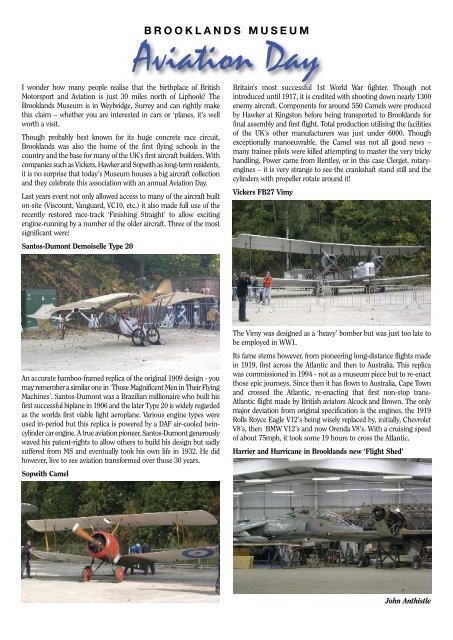Liphook Community Magazine Spring 2018
The Liphook Community Magazine exists to help maintain, encourage and initiate aspects of community life in which individuality, creativeness and mutual fellowship can flourish. It is produced and distributed by volunteers, free, to every household in the Parish of Bramshott and Liphook. It is financed by advertising and donations from individuals and organisations.
The Liphook Community Magazine exists to help maintain, encourage and initiate aspects of community life in which individuality, creativeness and mutual fellowship can flourish. It is produced and distributed by volunteers, free, to every household in the Parish of Bramshott and Liphook. It is financed by advertising and donations from individuals and organisations.
You also want an ePaper? Increase the reach of your titles
YUMPU automatically turns print PDFs into web optimized ePapers that Google loves.
B R O O K L A N D S M U S E U M<br />
Aviation Day<br />
I wonder how many people realise that the birthplace of British<br />
Motorsport and Aviation is just 30 miles north of <strong>Liphook</strong>? The<br />
Brooklands Museum is in Weybridge, Surrey and can rightly make<br />
this claim – whether you are interested in cars or ‘planes, it’s well<br />
worth a visit.<br />
Though probably best known for its huge concrete race circuit,<br />
Brooklands was also the home of the first flying schools in the<br />
country and the base for many of the UK’s first aircraft builders. With<br />
companies such as Vickers, Hawker and Sopwith as long-term residents,<br />
it is no surprise that today’s Museum houses a big aircraft collection<br />
and they celebrate this association with an annual Aviation Day.<br />
Last years event not only allowed access to many of the aircraft built<br />
on-site (Viscount, Vanguard, VC10, etc.) it also made full use of the<br />
recently restored race-track ‘Finishing Straight’ to allow exciting<br />
engine-running by a number of the older aircraft. Three of the most<br />
significant were:<br />
Santos-Dumont Demoiselle Type 20<br />
Britain's most successful 1st World War fighter. Though not<br />
introduced until 1917, it is credited with shooting down nearly 1300<br />
enemy aircraft. Components for around 550 Camels were produced<br />
by Hawker at Kingston before being transported to Brooklands for<br />
final assembly and first flight. Total production utilising the facilities<br />
of the UK’s other manufacturers was just under 6000. Though<br />
exceptionally manoeuvrable, the Camel was not all good news –<br />
many trainee pilots were killed attempting to master the very tricky<br />
handling. Power came from Bentley, or in this case Clerget, rotaryengines<br />
– it is very strange to see the crankshaft stand still and the<br />
cylinders with propeller rotate around it!<br />
Vickers FB27 Vimy<br />
An accurate bamboo-framed replica of the original 1909 design - you<br />
may remember a similar one in ‘Those Magnificent Men in Their Flying<br />
Machines’. Santos-Dumont was a Brazilian millionaire who built his<br />
first successful biplane in 1906 and the later Type 20 is widely regarded<br />
as the worlds first viable light aeroplane. Various engine types were<br />
used in-period but this replica is powered by a DAF air-cooled twincylinder<br />
car engine. A true aviation pioneer, Santos-Dumont generously<br />
waved his patent-rights to allow others to build his design but sadly<br />
suffered from MS and eventually took his own life in 1932. He did<br />
however, live to see aviation transformed over those 30 years.<br />
Sopwith Camel<br />
The Vimy was designed as a ‘heavy’ bomber but was just too late to<br />
be employed in WW1.<br />
Its fame stems however, from pioneering long-distance flights made<br />
in 1919, first across the Atlantic and then to Australia. This replica<br />
was commissioned in 1994 - not as a museum piece but to re-enact<br />
those epic journeys. Since then it has flown to Australia, Cape Town<br />
and crossed the Atlantic, re-enacting that first non-stop trans-<br />
Atlantic flight made by British aviators Alcock and Brown. The only<br />
major deviation from original specification is the engines, the 1919<br />
Rolls Royce Eagle V12’s being wisely replaced by, initially, Chevrolet<br />
V8’s, then BMW V12’s and now Orenda V8’s. With a cruising speed<br />
of about 75mph, it took some 19 hours to cross the Atlantic.<br />
Harrier and Hurricane in Brooklands new ‘Flight Shed’<br />
John Anthistle

















